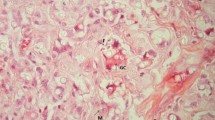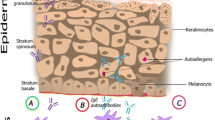Summary
Skin sections of clinically involved and clinically normal-looking skin from patients with atopic dermatitis were incubated with anti-human IgE antibodies using the indirect immunoperoxidase technique. Apart from positive dermal anti-IgE staining, positive epidermal anti-IgE staining was also observed. The morphology of the epidermal staining cells suggested the involvement of dendritic cells. This was confirmed by positive immuno-double labelling with OKT6 and anti-IgE. This phenomenon seemed to be specific for atopic dermatitis since skin sections from normal nonatopic controls, patients with allergic asthma, contact dermatitis, and schistosomiasis showed no epidermal anti-IgE staining. To further elucidate the nature of the epidermal anti-IgE staining cells, epidermal cell suspensions were prepared from clinically involved skin from patients with atopic dermatitis. These cell suspensions also showed positive anti-IgE staining cells and positive immuno-double labelling with OKT6 and anti-IgE. Immunogold electron microscopy with anti-IgE on epidermal cell suspensions from patients with atopic dermatitis showed gold particles on the cell membranes of cells containing Birbeck granules, being Langerhans' cells. Epidermal cell suspensions from normal non-atopic controls were negative. The presence of IgE molecules on epidermal Langerhans' cells, which seems to be specific for patients with atopic dermatitis, provides an explanation for the high frequency of positive patch test reactions to inhalant allergens.
Similar content being viewed by others
References
Capron M, Capron A, Dessaint J, Johansson S, Prin L (1981) Fc-receptors for IgE on human and rat eosinophils. J Immunol 126:2087–2092
Capron A, Dessaint J, Capron M, Joseph M (1983) IgE receptors on different cell lines and their role in triggering different immunological mechanisms. In: Proceedings of the 12th Congress of the European Academy of Allergy and Clinical Immunology, pp 17–23
Capron M, Kusnierz J, Prin L, Spiegelberg H, Ovlague G, Gosset Ph, Tonnel A, Capron A (1985) Cytophilic IgE on human blood and tissue eosinophils: Detection by flow microfluorometry. J Immunol 134:1313–1318
Dorrington K, Bennick H (1978) Structure-function relationships in human immunoglobulin E. Immunol Rev 41:3–25
Feltkamp-Vroom T (1984) IgE auf Mastzellen. Allergologie 7:20–22
Hanifin J, Rajka G (1980) Diagnostic features of atopic dermatitis. Acta Derm Venereol (Stockholm) 92:44–47
Harrist T, Muhlbauer J, Murphy G, Mihm M, Bhan A (1983) T6 is superior to Ia (HLA-DR) as a marker for Langerhans cells and indeterminate cells in normal epidermis: a monoclonal antibody study. J Invest Dermatol 80:100–103
Ishizaka T, Ishizaka K (1974) Mechanisms of passive sensitization. IV. Dissociation of IgE molecules from basophil receptor at acid pH. J Immunol 112:1078–1084
Joseph M, Auriault C, Capron A, Vorng H, Viens P (1983) A new function for platelets: IgE-dependent killing of schistosomes. Nature 303:810–812
Joseph M, Tonnel A, Capron A, Voisin C (1980) Enzyme release and super oxide anion production by human alveolar macrophages stimulated with immunoglobulin E. Clin Exp Immunol 40:416–422
Juhlin L (1969) Immunoglobulin E in dermatoses (levels in atopic dermatitis and urticaria). Arch Dermatol 100:12–16
Juhlin L, Shelly W (1977) New staining techniques for the Langerhans cell. Acta Derm Venereol (Stockholm) 57: 289–296
Leung D, Bhan A, Schneebergen E, Geha R (1983) Characterization of the mononuclear cell infiltrate in atopic dermatitis using monoclonal antibodies. J Allergy Clin Immunol 71:47–56
Melewicz F, Spiegelberg H (1980) Fc-receptors for IgE on a subpopulation of human peripheral blood monocytes. J Immunol 125:1026–1031
Melewicz F, Zeiger R, Mellon M, O'Connor R, Spiegelberg H (1981) Increased peripheral blood monocytes with Fc-receptors for IgE in patients with severe allergic disorders. J Immunol 126:1592–1595
Michel J, Tonnel A, Torpier G, Capron A, Arnoux B, Benveniste J (1983) Involvement of immunogloblin E in the secretory processes of alveolar macrophages from asthmatic patients. J Clin Invest 71:211–230
Mitchell B, Chapman M, Pope F, Crow J, Jouhal S, Platts-Mills T (1982) Basophils in allergen-induced patch test sites in atopic dermatitis. Lancet 1:127–130
Ray M, Tharp M, Sullivan T, Tigelaar R (1983) Contact hypersensitivity reactions to dinitrofluorobenzene mediated by monoclonal IgE anti-DNP antibodies. J Immunol 131:1096–1102
Swainson J, Wilson P, Doré P, Pumphrey R (1983) Evidence for circulating complexes containing IgE in patients with atopic dermatitis. Int Arch Allergy Appl Immunol 76:237–242
Stalmann P, Aalberse R (1977) Quantitation of basophilbound IgE in atopic and non-atopic subjects. Int Arch Allergy Appl Immunol 54:144–120
Stalmann P, Wagenaar S, Swieringa J, van der Wal J, Feltkamp-Vroom T (1977) Cell-bound IgE on human mast cells and basophilic granulocytes in atopic and non-atopic subjects. Int Arch Allergy Appl Immunol 54:433–450
Thorbecke G, Silberberg-Sinakin G, Flott T (1980) Langerhans cells as macrophages in skin and lymphoid organs. J Invest Dermatol 75:32–43
Yodoi J, Iskizaka K (1979a) Lymphocytes bearing Fc-receptors for IgE. 1. Presence of human and rat lymphocytes with Fc ε-receptors. J Immunol 122:2577–2583
Yodoi J, Iskizaka K (1979b) Lymphocytes bearing Fc-receptors for IgE. 3. Transition of Fc γR+ cells to Fc εR+ cells by IgE. J Immunol 123:2004–2010
Zachary C, Allen M (1985) In situ quantification of T-lymphocyte subsets and Langerhans cells in the inflammatory infiltrate of atopic eczema. Br J Dermatol 112:149–156
Author information
Authors and Affiliations
Rights and permissions
About this article
Cite this article
Bruynzeel-Koomen, C., van Wichen, D.F., Toonstra, J. et al. The presence of IgE molecules on epidermal langerhans cells in patients with atopic dermatitis. Arch Dermatol Res 278, 199–205 (1986). https://doi.org/10.1007/BF00412924
Issue Date:
DOI: https://doi.org/10.1007/BF00412924




